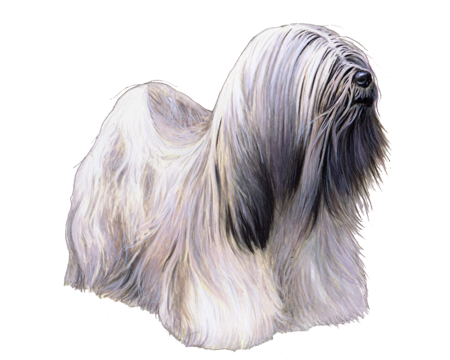
Pekingese
Pekingese are little dogs with big personalities. Known as an independent, headstrong, and confident breed, Pekingese know just how to charm their ways into their family’s hearts.
Interested in discovering if your dog is a Pekingese?
Check out Wisdom Panel's DNA tests.

Pekingese Traits
General Appearance
The toy breed is small in stature with well-balanced proportions and a regal bearing. Pekingese are known for their “rolling” gait and bold demeanors.
Coat and Coloring
Pekingese have thick, soft undercoats and long, straight, coarse-textured outer coats that stand off of their small bodies. Their hair is longest around the neck and shoulders, creating the “mane” that defines the breed. The forelegs, backs of the thighs, and toes have long feathering, and there is fringing on the ears and tail. The breed standard does not permit trimming their coats.
Pekingnese come in several colors with biscuit, black, black and tan, cream, fawn, fawn sable, red, gray, red sable, and white being the most common. The breed standard permits all colors and markings.
Distinctive Physical Traits
Pekingese are a flat-faced breed. Their topskull is massive, broad, and flat. In profile, their faces are flat with the chin, nose, and brow all lying on one plane that slants back from chin to forehead.
Pekingnese also have heart-shaped ears that lie flat against their heads, large, dark, round, wide-set eyes with black rims, and wide, open nostrils. Their bodies are compact and low to the ground, and their tails have long, profuse straight fringing and are carried well over their backs.
Pekingese Temperament
Pekingese have never forgotten their noble beginnings. These dogs are dignified, self-important, and intelligent. Although their owners often call them “opinionated,” Pekingese are not known for being big barkers. Their quiet natures make them popular as apartment dogs. These little pups can also learn to use indoor potty pads.
Pekingese might be small in size, but these dogs have big hearts. Consummate lapdogs, “Pekes” are loyal and affectionate with their owners. The breed tolerates gentle children but tends to develop a strong bond with a single person. They are suspicious of strangers, including unfamiliar dogs, but proper introductions can help them feel more at ease.
This breed is outgoing and alert and makes an effective little watchdog. However, their stubborn, willful natures can make Pekingese hard to train.


Pekingese History
Pekingese are among the oldest recorded dog breeds in the world. The breed dates back to ancient China, where it was known as the “ha pa dog”—and later, the famous “foo dog”—and bred to resemble the lion as a sign of good luck.
Nobles kept Pekingese as pampered lapdogs. Sometimes called “sleeve dogs” because they could hide in the large sleeves of Chinese robes, Pekingese were accustomed to going everywhere with their doting owners. Palace eunuchs oversaw strict breeding programs, and Pekingese ownership was limited to those in the highest social classes. The dogs were so esteemed that commoners had to bow in their presence, and stealing a Pekingese was punishable by death.
A British captain found five Pekingese dogs in a palace when troops invaded Peking (Beijing) in 1860. The dogs were transported back to England and given to Queen Victoria. These dogs with royal bearing fast became popular across Europe and, later, America. Ownership was once accessible to only the wealthiest families, but Pekingese are now among the most popular toy breeds.
Pekingese Care
Nutrition
Feed Pekingese a high-quality dog food that is appropriate for their age and small size. To keep this breed from becoming overweight, portion out their food with a measuring cup to avoid overfeeding, and limit treats to no more than 10% of their daily calories.
Grooming
Pekingese have thick double coats that require regular grooming. Occasional baths (with conditioner) and brushing at least once per week can keep their hair from becoming tangled or matted. Pekingese will require almost-daily brushing during shedding season (in spring and fall) to help remove their dead coat.
Their nails need regular trimming to keep them from cracking, splitting, or becoming overgrown and making it painful to walk or run.
Start a regular dental care routine when Pekingese are puppies. Brushing their teeth and scheduling professional cleanings ensures good oral hygiene throughout their lives.
Exercise
Pekingese do not require a lot of exercise. An occasional walk around the block or romp in a fenced yard are enough to satisfy these little dogs. Pekingese overheat easily and are not well-suited to vigorous exercise, especially during hot weather.
Provide opportunities for mental and physical stimulation, such as games and puzzle toys, to keep this intelligent breed engaged and active. Some Pekingese may enjoy activities such as competitive obedience or agility.
Training
Pekingese are outgoing, intelligent, and loving—but also stubborn. This combination can make them both want to please their owners and unwilling to follow directions. A consistent training program that incorporates positive reinforcement and rewards can encourage this breed to participate in training sessions. Engage their outgoing personalities with group sessions and games. Regular socialization is also important to make these dogs feel comfortable with unfamiliar people, pets, and places.

Pekingese Genetic Health Conditions
-
Chondrodystrophy (CDDY) and Intervertebral Disc Disease (IVDD) Risk
Chondrodystrophy (CDDY) is a skeletal disorder characterized by shortened limbs and abnormal early degeneration of the spinal discs, or intervertebral disc disease (IVDD), which predisposes to disc herniation.
Knowing if your Pekingese is a carrier or at-risk for these conditions can help you and your veterinarian plan for your pup’s lifelong care. With Wisdom Panel™ Premium, you can get results for over 200 genetic health tests.
Breed Group
Companion
This group consists of dogs typically bred for the specific purpose of human companionship, and many are popular pets because of their gentle nature. They became more common as the concept and luxury of dogs as pets prevailed.



























_Color.png)





















